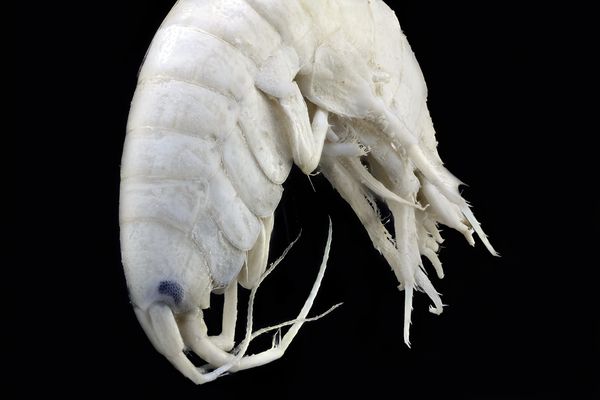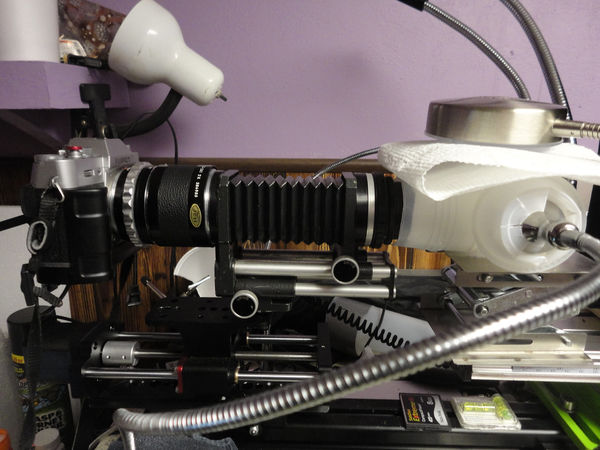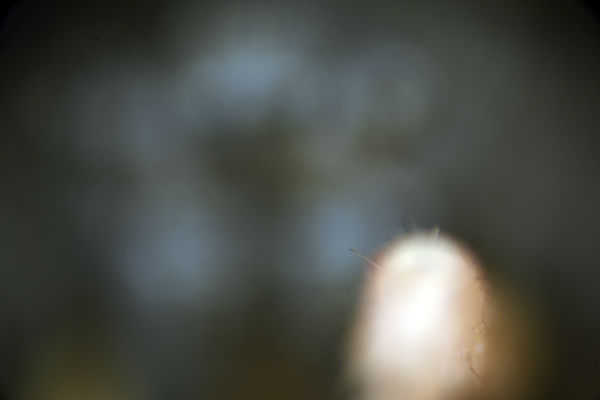Freshwater Amphipoda
Feb 10, 2020 17:27:08 #
This is one of the preserved Freshwater Amphipoda provided by Bill (newtoyou) and this is a tip-of-the-hat to him and his skills of collecting and identifying such interesting subjects.
Perhaps Bill will join in and provide us some items of interest on where to find these amazing critters and if they can be raised outside of the wild.
It is yet another in the series of focus stacked images and this one was taken the the reversed 50mm lens mounted on the reverse mounted magnifying lens mounted on bellows.
As always, thanks in advance to all who view and for your comments, suggestions, questions and critique.
Perhaps Bill will join in and provide us some items of interest on where to find these amazing critters and if they can be raised outside of the wild.
It is yet another in the series of focus stacked images and this one was taken the the reversed 50mm lens mounted on the reverse mounted magnifying lens mounted on bellows.
As always, thanks in advance to all who view and for your comments, suggestions, questions and critique.
Feb 10, 2020 21:06:37 #
👍 There can be marine or freshwater species. Freshwater they will hang out around floating algae strands.
Feb 11, 2020 04:18:33 #
I was thinking it was white because it was dead/preserved but on reading about them it seems that those who live in water are white but turn red when dead - how strange.
Feb 11, 2020 08:21:14 #
Feb 11, 2020 10:27:19 #
sippyjug104 wrote:
This is one of the preserved Freshwater Amphipoda ... (show quote)
These are just now becoming active.
They are found in the spring runoff along road ditches.
Very clear and cold water.
They dissapear once the ditches dry, not reappearing till the next spring.
I find all stages, so they must over winter in all active stages.
As was said, they are a clear whitish color in life. When put in alcohol, they dye the alcohol pink. Then they look as you are seeing them.
Never found them with eggs, so they do not hold them like shrimp.
Lastly, they do not tolerate warm or impure water, but like it almost freezing. Because of higher oxygen level?
If I put them in my aquarium, they die in a short time.
Bill
Feb 11, 2020 11:47:01 #
newtoyou wrote:
These are just now becoming active. br They are fo... (show quote)
Thanks Bill, these are surely the most strange specimen in the collection you provided and I would have never seen one without it.
Feb 11, 2020 11:48:16 #
Mark Sturtevant wrote:
👍 There can be marine or freshwater species. Freshwater they will hang out around floating algae strands.
Thanks Mark, Mother Nature never ceases to amaze me.
Feb 11, 2020 11:48:53 #
EnglishBrenda wrote:
I was thinking it was white because it was dead/preserved but on reading about them it seems that those who live in water are white but turn red when dead - how strange.
Brenda, they are quite strange indeed.
Feb 11, 2020 11:50:43 #
tinusbum wrote:
very nice!!!
Thanks, I enjoy seeing things under magnification and I enjoy sharing them even more.
Feb 11, 2020 22:50:45 #
Very nice stack. Good lighting and detail. I've been following your posts for a while now and i'm curious what range of magnification your able to get. I wasn't able to find any mention of what kind of "Magnifying lens" you're using. It seems to work very well with your reversed lenses and bellows. I've tried reverse stacking lenses on a Raynox DCR-150 but haven't been impressed. Thanks for posting your photos. Great variety.
Feb 12, 2020 12:32:17 #
naturepics43 wrote:
Very nice stack. Good lighting and detail. I've been following your posts for a while now and i'm curious what range of magnification your able to get. I wasn't able to find any mention of what kind of "Magnifying lens" you're using. It seems to work very well with your reversed lenses and bellows. I've tried reverse stacking lenses on a Raynox DCR-150 but haven't been impressed. Thanks for posting your photos. Great variety.
Thanks for the compliment and I enjoy sharing what I do and my techniques. I do use the Raynox DCR-150 as the magnifying lens when using lenses and as the 'tube lens' when using Infinity Microscope Objectives for it has an effective focal length of 208mm when focused to infinity.
My 'trick' is that in addition to mounting it in reverse, I mount a 'flat depth of field' enlarger lens in reverse on to it. Those two lenses are then mounted onto a bellows, extension tubes or a helicoid depending upon the size of the subject and what I am trying to showcase of it. I have several enlarger lenses in my collection and the smaller the mm the greater the magnification. My sweet-spot is the 28mm f/4. I also use a 2X teleconverter so in effect I have three lenses on my rig as you can see in this picture.
When I want to get closer I move into the microscope objectives which I can go to 40X however I found it to be quite useless to go much more than 15X for I lose context of what it is that I am looking at unless it is something like a mold spore.
Feb 12, 2020 22:54:43 #
Sippyjug,
Thanks for the detailed info and photo of your rig. I think I'll try your system and use my bellows. I'll let you know if it works out. Thanks again for your help.
Thanks for the detailed info and photo of your rig. I think I'll try your system and use my bellows. I'll let you know if it works out. Thanks again for your help.
Feb 12, 2020 23:05:33 #
naturepics43 wrote:
Sippyjug,
Thanks for the detailed info and photo of your rig. I think I'll try your system and use my bellows. I'll let you know if it works out. Thanks again for your help.
Thanks for the detailed info and photo of your rig. I think I'll try your system and use my bellows. I'll let you know if it works out. Thanks again for your help.
It's always fun to experiment. When you venture into reversed lenses mounted in series with each other the depth of field becomes nil so only a small spot of a subject, perhaps just the tip of a hair, will be in sharp focus like the "start" image of the Brown Recluse Spider shown here. The camera has to start, shoot, travel, stop, shot, travel, stop shoot, travel.....until it reaches the last spot of the subject that you want to include in focus.
If you look at this picture very closely you will see the faint face and fangs of the spider out of focus in the background and it is only a millimeter or so away from the hair on the leg. That's how shallow this technique is.
If you want to reply, then register here. Registration is free and your account is created instantly, so you can post right away.








